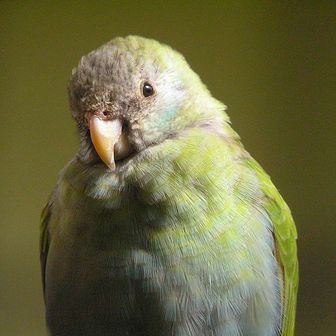Hooded Parrot
An Australian endemic, the Hooded Parrot inhabits to semi-arid areas of northeast Northern Territory. It nests in a termite mound. The female lays two to four white eggs. The diet consists mainly of seeds, berries and vegetables.

Original source: originally posted to Flickr as parkiet xxx and uploaded to commons at Psephotus_dissimilis_(female)_-Burgers_Zoo-8a.jpg: frank woutersderivative work: Snowmanradio (talk)
Author: originally posted to Flickr as parkiet xxx and uploaded to commons at Psephotus_dissimilis_(female)_-Burgers_Zoo-8a.jpg: frank woutersderivative work: Snowmanradio (talk)
The Hooded Parrot is classified as Least Concern. Does not qualify for a more at risk category. Widespread and abundant taxa are included in this category.
The Hooded Parrot, Psephotus dissimilis is a medium-sized, up to 26cm long, turquoise blue parrot with black head, green wing, brown back and greenish blue-bronze tail feathers edged with white. It has pale grey beak, greyish brown legs and brown eye. The female is an olive green parrot with pale blue below. An Australian endemic, the Hooded Parrot inhabits to semi-arid areas of northeast Northern Territory. It nests in a termite mound. The female lays two to four white eggs. More
The Hooded Parrot is one of three species of Psephotus that nest, or nested, in burrows in termite mounds. Of these, the Paradise Parrot is, alas, extinct, the Golden-shouldered of Cape York is, sadly, endangered, and only the Hooded Parrot of the Top End of the Northern Territory is tolerably secure. That said, its range is limited – South Alligator River in the east to Pine Creek in the west and Mataranka in the south – and is more restricted than formerly. More
胡迪氏鸚鵡 Hooded Parrot Psephotus dissimilis 圖片原址:http://bluebonnet.at.infoseek.co.jp/ 圖片原址:http://birdway.com.au/ 本文由原作者Paleo,P醫師授權轉載↓ 由於受到棲地被破壞的影響,現今野生的胡迪氏鸚鵡只見於澳洲北領地的北部,東至麥克阿瑟河,西至松溪的一小塊地區.即使在保育區內,不難發現此嬌客的身影,例如卡卡度國家公園裡至少還有12,000隻野生胡迪氏鸚鵡,但澳洲其他地方,以及世界各地的鸚鵡繁殖場,都不易見到這種被列為CITES一級保育鳥種的稀有鸚鵡. 胡迪氏鸚鵡的身材十分嬌小,從頭到尾差不多為28公分,但尾巴的長度幾乎就佔了一半.公母鳥成鳥的羽色截然不同,十分容易分辨.性成熟及換成成鳥羽色的年齡約在12-16月齡.公鳥的前額為黑色,臉頰,喉,胸及腹部為藍綠色.翅膀上的覆羽有一區塊為明顯的黃色.母鳥及亞成鳥的羽色相當,全身的羽毛大致為灰綠色. 胡迪氏鸚鵡的叫聲輕柔,不吵雜.多半於清晨聚集於草原或水岸邊進食,飲水.喜歡玩水,也經常在地面活動.個性並不擔怯.不過原產於熱帶草原的牠們,較不適應寒冷潮濕的氣候.人工飼養的環境中,需特別防範寒害. 除了樹洞外,牠們也會以白蟻窩掘穴為巢.每次產卵數約2-6顆,由母鳥獨立孵蛋.19-20天幼鳥孵化出,35天左右羽翼長齊.人工繁殖的巢箱,適合的大小約長寬高各為15,15,40公分.洞口直徑5公分,以木屑為墊料.飼養的籠舍大小,不需像其他大型長尾鸚鵡那麼大.繁殖期的鳥攻擊性強,不可與其他鳥種共飼於同籠. 目前並未發現胡迪氏鸚鵡有任何變種,不過曾發現牠們和紅腰鸚鵡及馬迦鸚鵡(mulga parrot)雜交. 本文由原作者Paleo,P醫師授權轉載↑ HEMiDEMi Technorati Del.icio.us MyShare個人書籤 Yahoo 標籤: 04. More
hooded parrot (Psephotus dissimilis), a small grass parrot that inhabits the tropical savannas of northern Australia. More
Hooded ParrotPsephotus chrysopterygius dissimilis Closely related to the Golden Shouldered Parrot and is also in some trouble in its habitat due to pressure from cattle and a burning program that is detrimental to the native grasses that it feeds on. However a large number of birds are bred each year in aviaries so the bird has a secue future. The Hooded Parrot nests in April to June, lays three to five eggs which take 20 days to hatch. More
The Hooded Parrot, Psephotus dissimilis, is an Australian endemic; specifically, it inhabits to semi-arid areas of northeast Northern Territory. Though this species has disappeared from most of its original range, it remains common in protected areas. The Hooded Parrot occupies the very northeastern region of the Northern Territory while the nominate Golden-shouldered Parrot is limited to the Cape York Peninsula. Description: This medium-sized parrot averages 28 cm (11 ins) in length. More
hooded parrot photo* An Australian Parrot (Click on photo to enlarge) * Scientific Name: Psephotus dissimilis * Common Name/s: HOODED PARROT, ANTHILL PARROT, BLACK HOODED PARROT. * Sub Species: None * Origin / Distribution: Northern Territory. * Habitat In Wild: Dry open eucalypt forest and grasslands. Areas to include active termite mounds. More
Hooded Parrot Psephotus dissimilis 2009 IUCN Red List Category (as evaluated by BirdLife International - the official Red List Authority for birds for IUCN): Least Concern Justification Although this species may have a restricted range, it is not believed to approach the thresholds for Vulnerable under the range size criterion (Extent of Occurrence 30% decline over ten years or three generations). More
The Hooded Parrot is a sub species of the Golden-shouldered Parrot. As far as I am aware there are no golden shouldered in the USA. More
The Hooded Parrot is quite uncommon and requires some very specific habitat. They nest in termite mounds. Posted 36 months ago. ( permalink ) Would you like to comment? Sign up for a free account, or sign in (if you're already a member). Guest Passes let you share your photos that aren't public. Anyone can see your public photos anytime, whether they're a Flickr member or not. More
The Hooded Parrot breeds only in open woodland and savanna in Arnhemland (N Territory, Australia). The male is turquoise blue with a black head, yellow shoulders, grey back and greenish blue-bronze tail feathers edged with white. The female is olive green with pale blue below. This parrot excavates its nest in a termite mound, where the female lays two to four white eggs. More
Did You Know?The Hooded Parrot nests in terrestrial termitaria (termite mounds on the ground). The tunnel to the nest goes into the centre of the mound, where the temperature is stable. WPT Members Only Resources Please log-in now to find more parrot research, resources and tools. Join Now Find more research You will gain access to 400+ pages of additional research, access to parrot experts and other downloadable resources... More
The Golden-shouldered parrot, like it's cousin the Hooded parrot is a relatively small bird of swift flight. When comparing the Shouldereds with the rest of the genus, they are a somewhat more slender and a finer-featured bird. A cock bird in full feather often gives the appearance of possessing a tail that is out of proportion to the rest of its slender body. More
Hooded Parrot, Northern Territory, Aus, Fergusson River July 2007 © Rob Morris The next morning produced a number of Hooded Parrots and loads of Gouldian Finches Send this as a postcard Hooded Parrot - Showing Records 1 through 4 of 4 Total Records More
The Hooded Parrot is evaluated as Least Concern on IUCN Red List of Threatened Species. References - * BirdLife International (2004). Psephotus dissimilis. 2006 IUCN Red List of Threatened Species. IUCN 2006. Retrieved on 31 October 2006. Database entry includes justification for why this species is of least concern This article is licensed under the GNU Free Documentation License. More
Family : Psittacidae
Genus : Psephotus
Species : dissimilis
Authority : Collett, 1898

